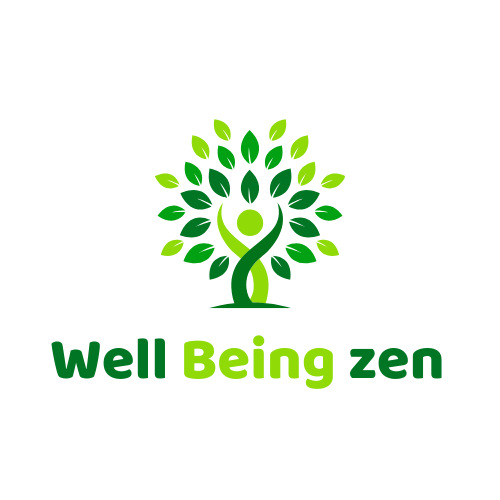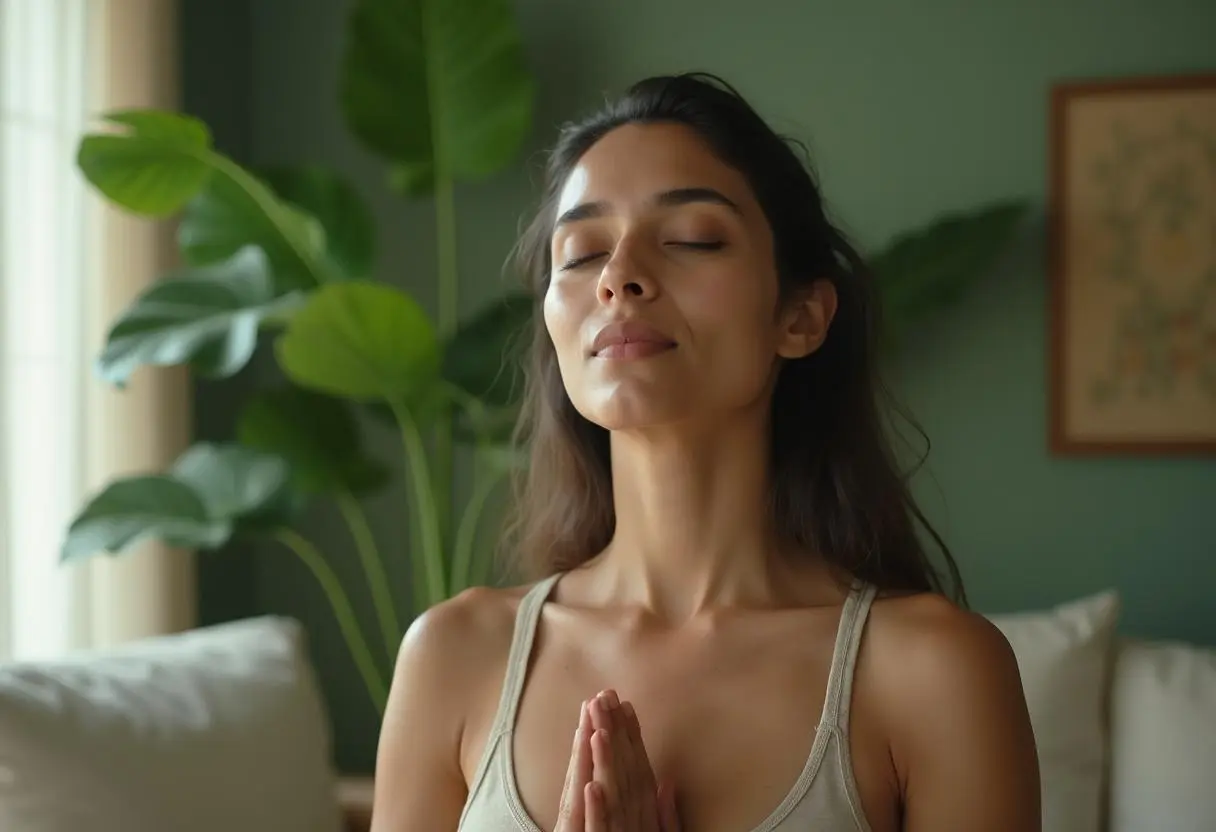Take a moment and notice your breath. Is it shallow and quick, caught high up in your chest? Are your shoulders tense, creeping up towards your ears? In our hyper-connected, fast-paced world, this state of low-grade, chronic stress has become our default. We live in a constant state of “on,” and our bodies and minds are paying the price.
We feel overwhelmed, mentally foggy, and emotionally frayed. This tension isn’t just in our heads; it lives in our bodies—in our tight jaws, aching necks, and churning stomachs. We search for complex solutions to this modern problem, often forgetting the most profound and accessible tool we have to reclaim our calm: our own breath.
What if you could shift your entire nervous system from a state of frantic stress to one of deep peace in just a few minutes, using nothing more than a conscious inhale and exhale?
This is the promise of Pranayama, the ancient yogic science of breath control. It’s not about just breathing; it’s about breathing with intention. Today, we invite you to explore five of the most effective pranayamas to reduce stress. This isn’t just another to-do list for your wellness routine; this is your personal toolkit for finding stillness in the midst of chaos.
Table of Contents
The Forgotten Language of Your Body: Understanding the Power of Breath
Your breath is the remote control for your nervous system. When you’re stressed, your sympathetic nervous system—your “fight or flight” response—takes over. Your heart rate increases, your muscles tense, and your breathing becomes rapid and shallow.
Pranayama is the practice of consciously overriding this automatic response. By intentionally slowing down and deepening your breath, you activate your parasympathetic nervous system—your “rest and digest” mode. This simple act sends a powerful signal to your brain that you are safe, allowing your entire body to release, relax, and recover.
The word Pranayama comes from Sanskrit: Prana, meaning “life force energy,” and Ayama, meaning “to extend or regulate.” Through these practices, you are not just calming your mind; you are actively managing your life force energy, creating a reservoir of peace that you can tap into anytime, anywhere.
Your Toolkit for Calm: 5 Effective Pranayamas to Reduce Stress and Tension
Ready to experience this transformation for yourself? Find a comfortable seated position, lengthen your spine, and let’s explore these five powerful breathing techniques together.
1. Anulom Vilom (Alternate Nostril Breathing): The Great Balancer
If your mind feels scattered and your thoughts are racing, Anulom Vilom is your anchor. This practice is renowned for its ability to restore balance to the mind and body, synchronizing the left and right hemispheres of the brain.
Why It Works for Stress: By consciously directing the breath through each nostril, you calm the rhythm of the mind and soothe the entire nervous system. It promotes clear thinking and a state of harmonious equilibrium.
Step-by-Step Guide:
- Sit comfortably with your spine straight. Rest your left hand on your left knee.
- Bring your right hand up to your face and form Vishnu Mudra by folding your index and middle fingers into your palm, leaving your thumb, ring finger, and pinky finger extended.
- Close your eyes and take a deep breath in and out through both nostrils.
- Gently close your right nostril with your right thumb. Inhale slowly and deeply through your left nostril for a count of four.
- Close your left nostril with your ring finger, so both nostrils are now closed. Hold the breath for a moment.
- Release your thumb from the right nostril and exhale slowly through the right nostril for a count of six or eight.
- Now, inhale through the right nostril for a count of four.
- Close the right nostril, hold for a moment, and then exhale through the left nostril for a count of six or eight.
- This completes one full round. Continue for 5-10 rounds.
- Beginner’s Tip: Focus on making your breath smooth and silent. Don’t worry about the counts initially; just get comfortable with the alternating flow.
- Best Time to Practice: Morning to set a calm tone for the day, or anytime you feel mentally scattered.
2. Bhramari Pranayama (Humming Bee Breath): The Instant Soother
This is one of the most immediately effective pranayamas to reduce stress and agitation. The gentle vibration created by the humming sound is like an internal massage for your nervous system, instantly dissolving tension.
Why It Works for Stress: The sound vibration directly stimulates the vagus nerve, which activates the parasympathetic nervous system. It has been shown to release nitric oxide, a vasodilator that helps lower blood pressure and improve circulation, promoting deep relaxation.
Step-by-Step Guide:
- Sit upright in a quiet corner. Gently close your eyes.
- Place your index fingers on the cartilage of your ears, just between your cheek and ear.
- Take a deep breath in.
- As you exhale, gently press the cartilage to close your ears. Keeping your mouth closed, make a low- to medium-pitched humming sound from the back of your throat, like the sound of a bee.
- Hum for the entire duration of the exhale. Feel the vibration resonate in your skull.
- This is one round. Practice 5-7 rounds.
- Beginner’s Tip: Don’t press too hard on your ears. The touch should be light. Focus entirely on the internal sensation of the vibration.
- Best Time to Practice: Before bed to quiet the mind for sleep, or during a work break to release accumulated tension.
3. Ujjayi Pranayama (Victorious Breath or Ocean Breath): The Mindful Anchor
Often used during yoga asana practice, Ujjayi is a powerful technique for focusing the mind and grounding your energy. The sound it creates is a reminder to stay present and connected.
Why It Works for Stress: The slight constriction at the back of the throat slows the breath down, requiring you to be more mindful. The gentle, rhythmic sound—like ocean waves—is deeply hypnotic and calming, helping to quiet the endless loop of anxious thoughts.
Step-by-Step Guide:
- Sit comfortably and breathe naturally through your nose.
- Bring your awareness to the back of your throat. As you exhale, gently constrict the opening of your throat, as if you were about to whisper a “HAAAA” sound, but keep your lips closed.
- You should hear a soft, audible rushing or hissing sound, like the ocean.
- Once you are comfortable with the exhale, apply the same gentle constriction to your inhale.
- Your breath should be long, deep, and smooth, with a consistent sound on both the inhale and exhale.
- Continue for 10-15 breaths.
- Beginner’s Tip: To learn the sensation, try exhaling onto a mirror as if you were trying to fog it up. Now, recreate that same feeling in your throat with your mouth closed.
- Best Time to Practice: During yoga, meditation, or anytime you need to bring a scattered mind into a single point of focus.
4. Sheetali Pranayama (Cooling Breath): The Internal Air Conditioner
When stress manifests as heat, anger, or frustration, Sheetali is the perfect antidote. This practice literally cools your body and mind from the inside out.
Why It Works for Stress: The act of drawing breath over the moist surface of the tongue has a powerful cooling effect on the blood and the nervous system. It’s excellent for pacifying irritability and calming heated emotions.
Step-by-Step Guide:
- Sit in a comfortable position with your spine straight.
- Open your mouth and roll the sides of your tongue up to form a tube or a straw. (If you can’t, see the alternative below).
- Inhale slowly and deeply through the tube of your tongue, as if sipping air through a straw. Feel the cooling sensation.
- After the inhale, retract your tongue, close your mouth, and exhale slowly through your nose.
- Repeat for 8-12 rounds.
- Alternative (Sitkari): If you cannot roll your tongue, simply press your tongue against the back of your teeth and part your lips slightly. Inhale through the gaps in your teeth, creating a hissing sound. Exhale through the nose.
- Best Time to Practice: During hot weather, after a workout, or anytime you feel angry, frustrated, or agitated.
5. Bhastrika Pranayama (Bellows Breath): The Energizing Release
While most calming pranayamas are slow, Bhastrika is a dynamic practice designed to blast through physical and mental blockages. It powerfully releases stagnant energy and tension, leaving you feeling clear, invigorated, and surprisingly calm.
Why It Works for Stress: The rapid, forceful breathing floods the body with oxygen and expels carbon dioxide, purifying the system. It breaks up pranic blockages and releases deep-seated tension, and the period of calm after the active breathing is profound.
Step-by-Step Guide:
- Sit with a straight spine. Relax your shoulders.
- Take a deep breath in.
- Begin a series of forceful, active exhales followed by automatic, passive inhales. Both inhale and exhale are through the nose. The main effort is on the exhale, causing your abdomen to snap inwards.
- Start with a round of 10-15 sharp breaths.
- After the last exhale, take a deep breath in and hold it for as long as is comfortable.
- Exhale slowly. Rest for a moment, observing the feeling of stillness. This is one round. You can do 2-3 rounds.
- Caution: Avoid this practice if you are pregnant, have high blood pressure, heart disease, a hernia, or epilepsy.
- Beginner’s Tip: Start slowly with fewer repetitions. Focus on the sharp exhale and let the inhale happen naturally. Quality over quantity is key.
- Best Time to Practice: In the morning to clear away sluggishness and energize your mind for the day. Avoid practicing it late at night.
Conclusion: Your Breath is Always With You
Your breath is your most loyal companion. It is with you from the moment you are born until the moment you leave. In a world full of complexity, the solution to finding peace is radically simple. It is a conscious inhale, and a complete exhale.
You don’t need a special time, place, or equipment to practice. You only need the willingness to pause and connect with this incredible power you hold within. These pranayamas to reduce stress are not just techniques; they are invitations to come home to yourself, breath by breath.
Which of these pranayamas resonates with you the most? We invite you to choose one to try this week. Let it be your 5-minute oasis of calm. We would love to hear about your experience in the comments below.




